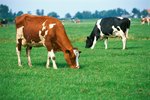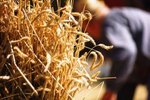Goatweed occurs in pastures, on roadsides and in areas where the soil has been disturbed. Its scientific name is Croton texensis, and its common name varies with the area in which it is growing. The plant is called Texas croton, doveweed, goatweed and skunkweed. This weed is not eaten by cattle and can be controlled by mowing or spraying with 2,4-D herbicide.
Geographic Distrubution

Goatweed occurs in blocks of states, with the blocks being scattered across the country. The biggest block includes Texas, New Mexico, Arizona, Utah, Colorado, Oklahoma, Kansas, Illinois, Wisconsin, Missouri, Iowa, Nebraska, South Dakota and Wyoming. Goatweed occurs in a two-state block of Alabama and Florida and in the single states of Maryland and Massachusetts.
Methods of Identification
One of the ways to identify goatweed is by the aromatic smell that occurs when its leaves are crushed. The plant varies in height from 1 to 4 feet tall, depending upon moisture conditions. This weed is easily recognized by its grayish to yellowish-green leaves. The leaves may be lighter in color on top and darker beneath. The fruit of the goatweed is a capsule divided into three segments supporting three individual seeds.
Habitat

Goatweed usually occurs in abundance on calcareous or sandy loam soils or in loose sands. Its appearance in pastures often indicates heavy grazing pressure or that the soil doesn't have adequate plant cover. Goatweed is an annual, which means that the plants die after maturity and next season's crops grow from seed.
Uses

Although goatweed has a low value for livestock grazing, its seeds are a valuable food for dove, quail and other birds. Lands managed for dove and quail are often disc-plowed to increase the amount of goatweed. Hopi Indians and pioneers used goatweed as a purgative. One drop of goatweed oil equals one or more ounces of castor oil.
Toxicity

Goatweed contains milky juice that causes skin irritation and blistering. Research tests show that 10 drops of goatweed oil taken internally will kill a dog, so it is highly toxic. There are also documented cases of humans being poisoned by honey made from goatweed nectar. Young bees have also been poisoned by the nectar. It is fortunate that goatweed is rarely eaten by grazing animals, or there would be cases of livestock poisoning.
References
- "Pasture and Range Plants"; Phillips Petroleum Company; 1963
- "Texas Range Plants"; Stephan Hatch and Jennifer Pluhar; 1993
Photo Credits
-
texas proud image by buckwheat from Fotolia.com




